Table of Contents
- Introduction
- Editor’s Choice
- History of Organ Donation
- Organ Transplantation Statistics
- Regional Organ Donation Statistics
- Kidney Donation Statistics
- Liver Donation Statistics
- Heart Donation Statistics
- Demographics of Organ Donors
- Key Cost Metrics
- Important Sources of Information on Organ Donation
- Popular Organ Donation Programs
- Regulations for Organ Donation
Introduction
According to Organ Donation Statistics, Organ donation is the process of transferring organs or tissues from a donor to a recipient in need due to organ failure.
It can involve living donors, such as those who donate a kidney or liver portion, or deceased donors, where organs are recovered after brain or cardiac death.
The process includes identifying suitable donors, obtaining consent, matching organs with recipients, and performing surgeries.
Organ donation is regulated to ensure ethical practices and fair access but faces challenges such as a shortage of donors and ethical concerns. Public awareness and education efforts aim to address these challenges and increase donor registration.
Editor’s Choice
- The Tissue And Organ Transplantation Market Size is projected to reach approximately USD 44 billion by 2033.
- In 2022, the estimated number of solid organ transplantations worldwide reached a total of 157,494.
- In 2022, the distribution of organ transplants worldwide varied significantly by organ type. Kidney transplants comprised the largest share, accounting for 65% of the total.
- In 2023, Spain led the world in deceased organ donors per million population, with a rate of 49.38.
- In a survey measuring the willingness of individuals to allow organ removal in the event of sudden death, Colombia topped the list, with 75% of respondents expressing their consent.
- In the United Kingdom (UK), during 2022/23, organ donors by age group were distributed in a diverse range. Donors aged 18-49 constituted the largest share at 36%.
- As of November 2023, the number of candidates waiting for organ transplants in the United States totaled 103,650.
- The Health Resources and Services Administration (HRSA) proposed a $36 million increase in the fiscal year 2024 budget, totaling $67 million for organ procurement and transplantation modernization initiatives.

History of Organ Donation
- The history of organ donation is marked by significant milestones and innovations that have advanced the field dramatically.
- In 1954, the first successful human organ transplant was performed with a kidney between identical twins.
- This breakthrough was followed by the first successful liver and pancreas transplants in 1967 and the first heart transplant performed by Dr. Christiaan Barnard the same year.
- Further advancements included the first successful heart-lung transplant in 1981, the first double-lung transplant in 1986, and the first living donor liver and lung transplants in the late 1980s and early 1990s.
- By 2021, the US achieved over 40,000 transplants in a single year, highlighting the continuous progress and the increasing generosity of donors.
Organ Transplantation Statistics
Number of Organ Transplantations Worldwide
- In 2022, the estimated number of solid organ transplantations worldwide reached a total of 157,494.
- Among these, kidney transplants were the most prevalent, accounting for 102,090 procedures.
- Liver transplants followed with 37,436 cases.
- Heart transplants were also significant, with 8,988 operations performed.
- Lung transplants totaled 6,784, while pancreas transplants accounted for 2,026 procedures.
- The number of small bowel transplants was comparatively low, with only 170 cases recorded.
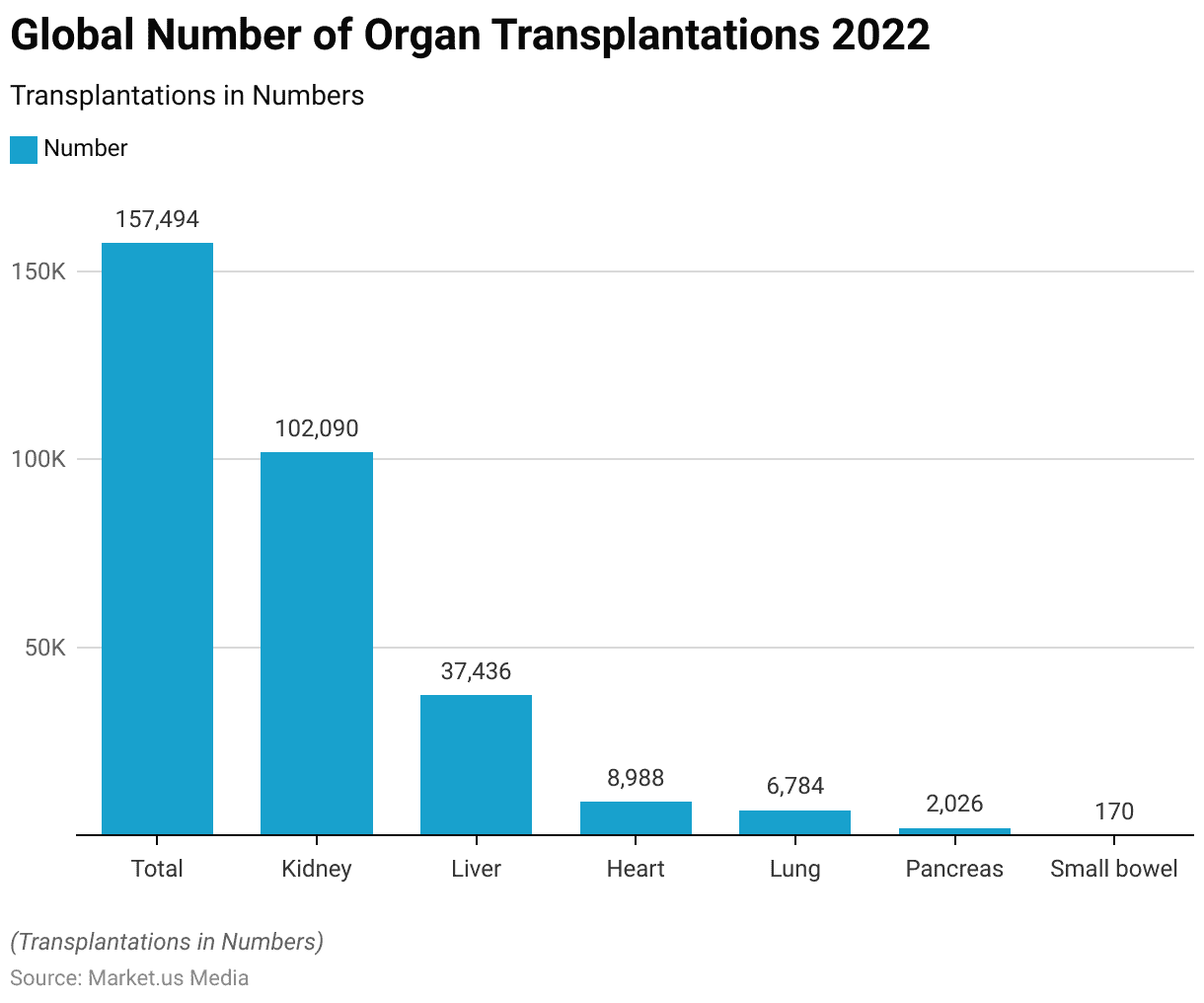
Distribution of Organ Transplants – By Organ Type
- In 2022, the distribution of organ transplants worldwide varied significantly by organ type. Kidney transplants comprised the largest share, accounting for 65% of the total.
- Liver transplants followed, representing 24% of the global total.
- Heart transplants constituted 6% of the overall figure, while lung transplants made up 4%.
- Pancreas transplants were relatively rare, comprising 1% of the total transplants performed.
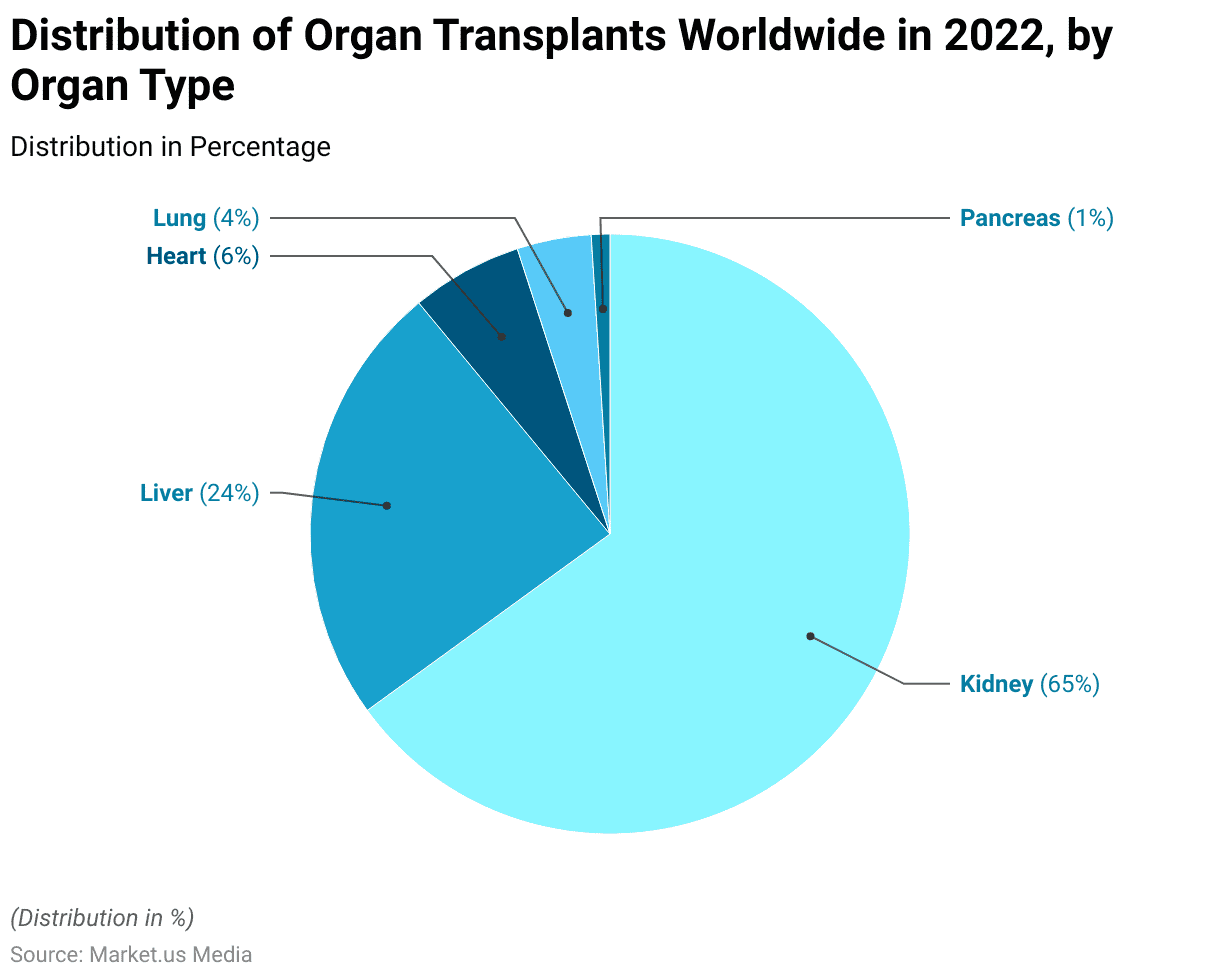
Regional Organ Donation Statistics
Living Organ Donor Rate – By Country
- In 2023, Turkey had the highest rate of living organ donors, with 53.8 donors per million population (pmp).
- Saudi Arabia followed with a rate of 46.42 pmp, and Israel had 34.02 pmp.
- The Netherlands reported a living organ donor rate of 30.34 pmp.
- The United States recorded 20.45 pmp, while Kuwait and Mexico had rates of 18.6 pmp and 17.01 pmp, respectively.
- Georgia and Syria both had living donor rates around 15 pmp, with 15.41 and 15.00 pmp, respectively; New Zealand also reported the latter rate.
- Cyprus had a rate of 13.08 pmp, and Switzerland recorded 12.50 pmp.
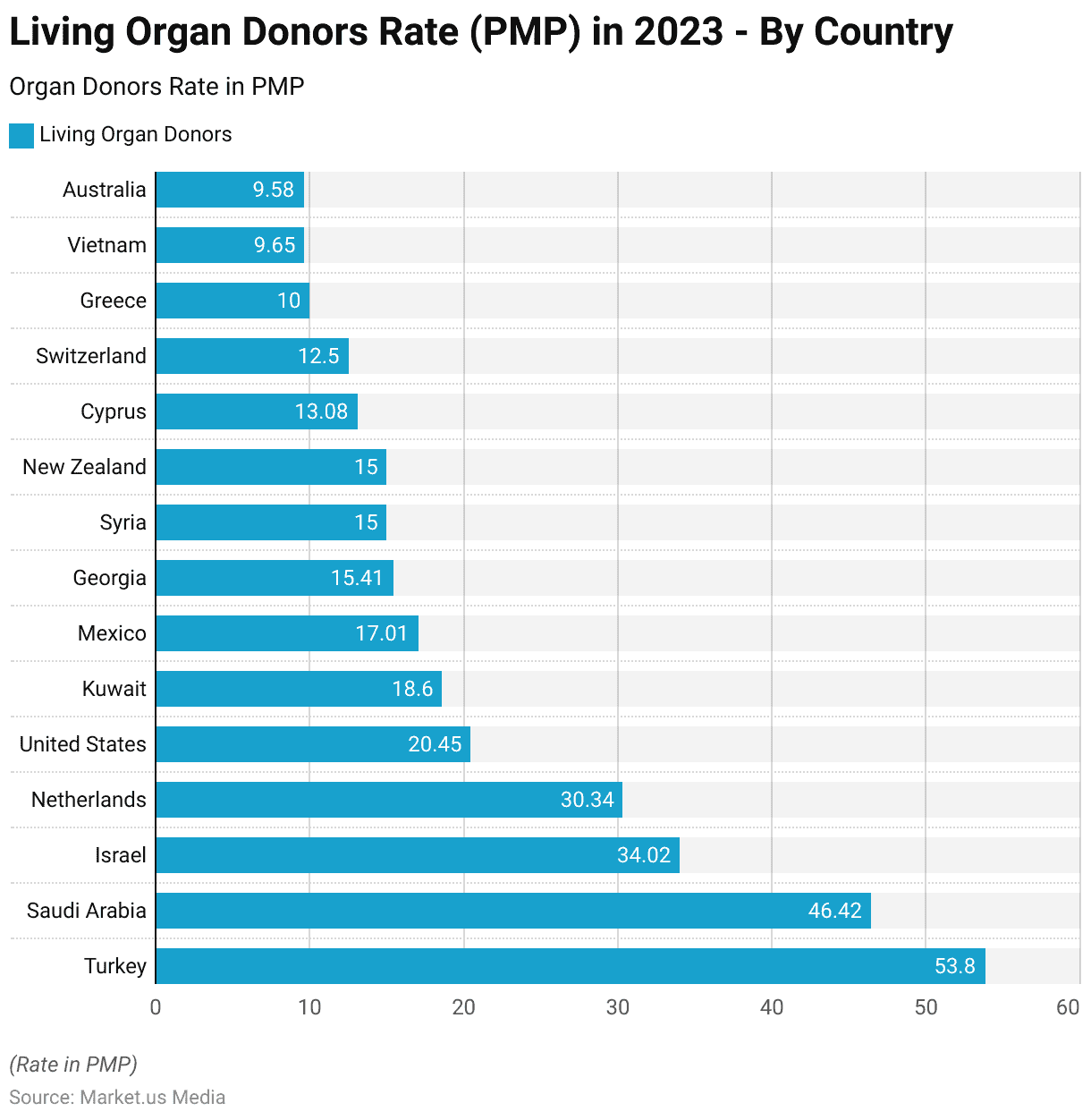
Kidney Donation Statistics
Global Kidney Transplants – By Region
- In 2022, the estimated number of kidney transplants performed worldwide varied significantly by region.
- The Americas led with 39,196 kidney transplants.
- Europe, including countries from the former Soviet Union, followed with 25,329 transplants.
- The Western Pacific region reported 18,219 kidney transplants, while Southeast Asia accounted for 12,696 procedures.
- In the Eastern Mediterranean region, 6,364 kidney transplants were performed. Africa had the lowest number, with only 286 kidney transplants conducted.

Liver Donation Statistics
Liver Transplants from Deceased Donors – By Country
- In 2023, the rate of liver transplants from deceased organ donors per million population varied across countries.
- The United States led with a rate of 29.41 per million population.
- Belgium and Croatia followed closely with rates of 26.84 and 26.75, respectively.
- Spain reported a rate of 26.52, and Portugal had 24.36 per million population.
- The Czech Republic recorded a rate of 17.24, while Switzerland had 16.48.
- Estonia and Austria reported similar rates, with 13.08 and 13.00, respectively.
- Poland had a rate of 12.93, and Lithuania reported 11.11 per million population.
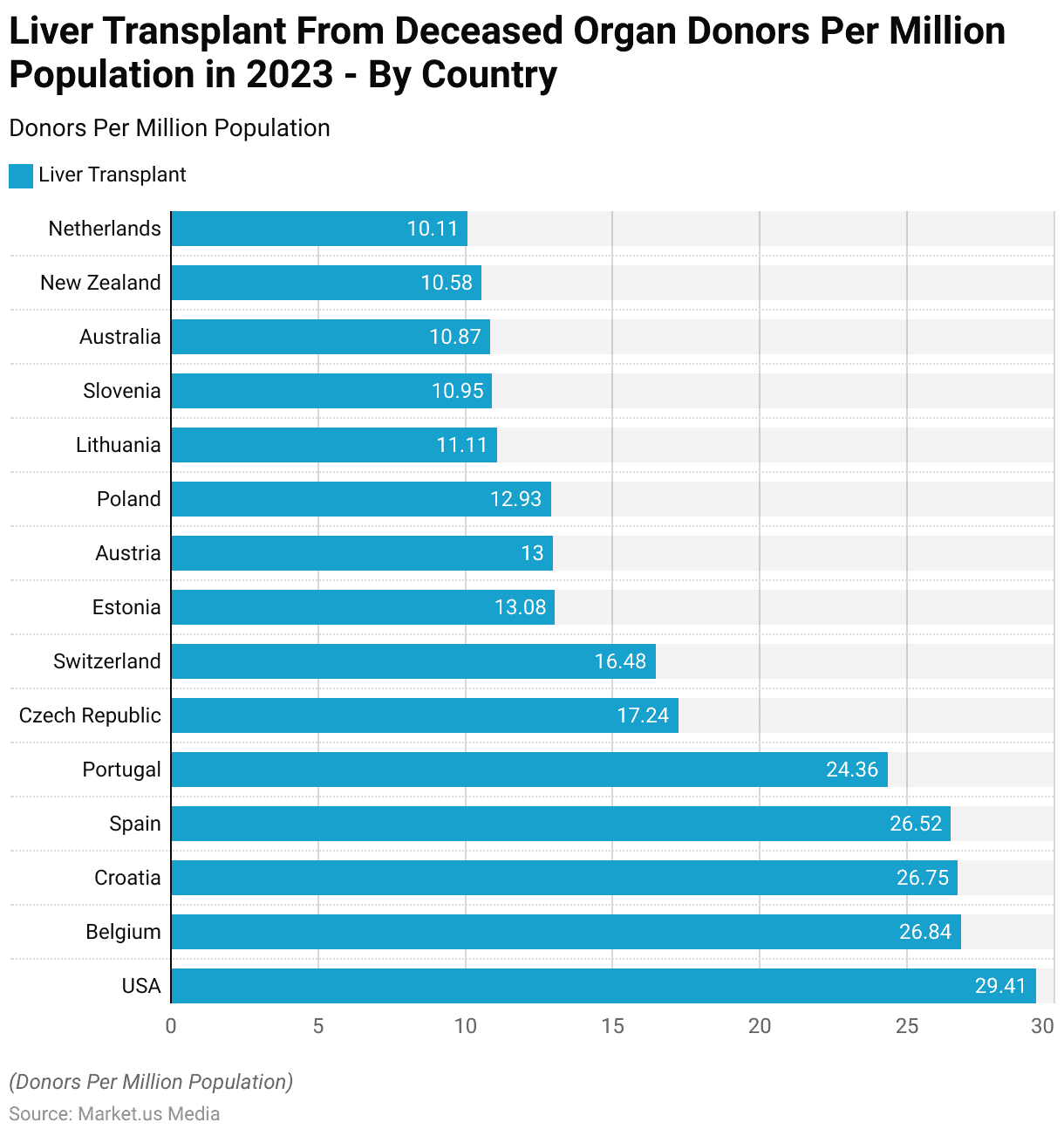
Heart Donation Statistics
Rate of Heart Transplants Worldwide
- Between 2011 and 2022, the rate of heart transplants worldwide showed a gradual increase.
- In 2011 and 2012, the rate was steady at 0.8 transplants per million populations.
- In 2019, the rate saw a significant jump to 1.5.
- However, the COVID-19 pandemic in 2020 caused a slight decline to 1.3.
- The rate rebounded in 2021 to 1.4 and maintained its upward trend, returning to 1.5 transplants per million populations in 2022.
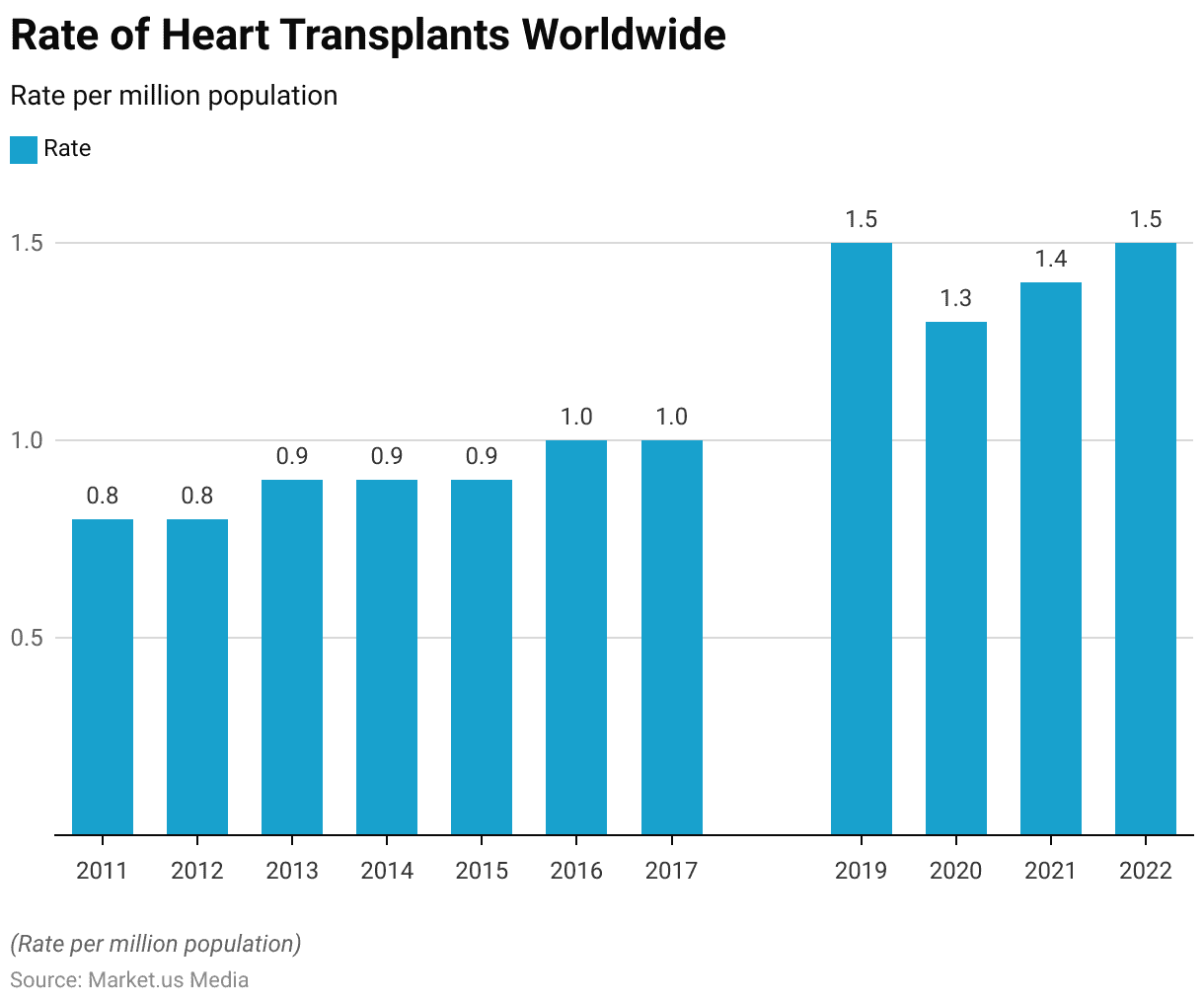
Demographics of Organ Donors
By Age
- In the United Kingdom (UK), during 2022/23, organ donors by age group were distributed in a diverse range.
- Donors aged 18-49 constituted the largest share at 36%.
- The 50-59 age group followed, accounting for 25% of donors.
- Those aged 60-69 represented 23% of the donor population, while donors aged 70 and over made up 14%.
- The youngest age group, 0-17, contributed 3% to the total number of organ donors.

By Gender
- Between 2013 and 2023, the number of organ donors in the United States showed a notable increase for both genders.
- In 2013, there were 7,016 female donors and 7,242 male donors. This number gradually increased each year.
- As of 2023, there were 7,734 female donors and 9,522 male donors.
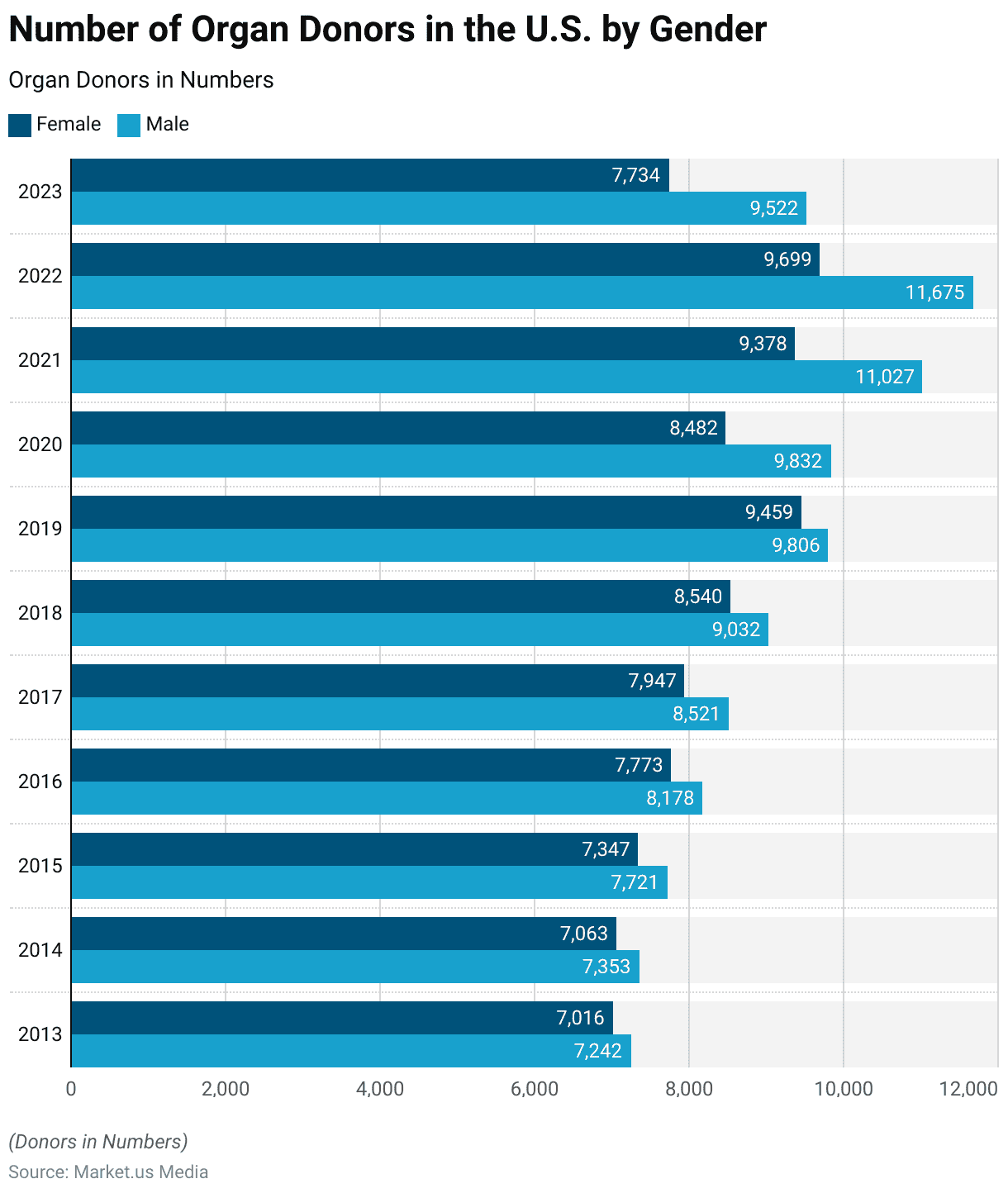
Key Cost Metrics
- As of 2020, the average amount charged for various organ transplantations in the United States varied significantly by organ.
- Heart transplants were the most expensive, with an average cost of $1,664,800.
- Intestine transplants followed, costing $1,240,700 on average.
- Allogenic bone marrow transplants averaged $1,071,700, while single lung transplants cost $929,600.
- Liver transplants were billed at an average of $878,400.
- Autologous bone marrow transplants had an average cost of $471,600, and kidney transplants averaged $442,500.
- Pancreas transplants were billed at $408,800 on average, while corneal transplants were the least expensive, costing $32,500.

Important Sources of Information on Organ Donation
- In 2012, US adults identified several important sources of information on organ donation.
- News coverage, including TV, radio, newspapers, and the Internet, was the most cited source, with 69.9% of respondents indicating it as their information source.
- Discussions with family members were also significant, mentioned by 52.6% of respondents, followed by conversations with friends at 49.4%.
- Advertisements on TV informed 47.1% of individuals, while motor vehicle offices were a source for 45.1%.
- Movies and TV shows contributed to awareness for 40.4% of respondents, and billboards or posters in public places were noted by 35.2%.
- Information from medical professionals, clinics, or doctor’s offices was important for 35.1%, and health-related or other websites were cited by 34.9%.
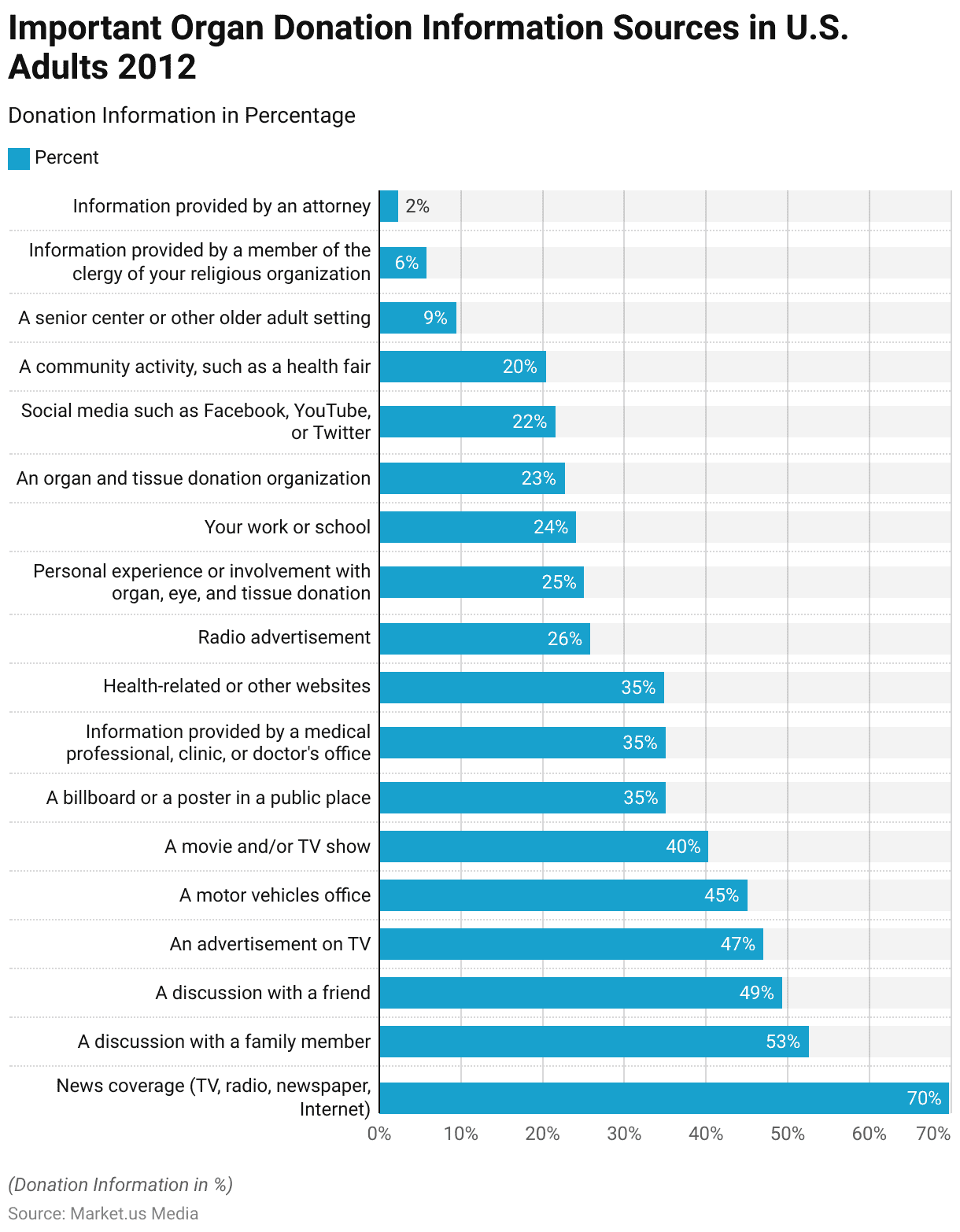
Popular Organ Donation Programs
- Several prominent organ donation programs have significantly contributed to saving lives through their structured initiatives and extensive outreach.
- The United Network for Organ Sharing (UNOS) manages the national transplant system. It operates the Organ Procurement and Transplantation Network (OPTN), focusing on equitable organ allocation and advancing transplantation technology and policy.
- In 2023, UNOS facilitated over 46,000 transplants, setting new records for kidney, liver, and lung transplants.
- Donate Life America is another key organization that promotes donor registration and awareness through national campaigns like National Donate Life Month and various local initiatives aimed at increasing donor registrations and educating the public about the importance of organ, eye, and tissue donation.
Regulations for Organ Donation
- Organ donation regulations vary widely by country, focusing on ethical practices, donor consent, and the prevention of organ trafficking.
- In the UK, an opt-out system, known as deemed consent, is in place across England, Wales, Scotland, and Northern Ireland, meaning individuals are considered willing donors unless they explicitly opt out.
- This system aims to increase the number of available organs for transplant while maintaining ethical standards.
- In the UAE, the Federal Decree-Law No. 25 of 2023 regulates organ and tissue transplantation, prohibits organ trafficking, and mandates the registration of donors through the national HAYAT registry linked to each individual’s Emirates ID.
- Globally, the World Health Organization (WHO) emphasizes the need for strict regulations to ensure the safety and ethical procurement of organs, advocating for systems that prevent exploitation and trafficking.
Discuss your needs with our analyst
Please share your requirements with more details so our analyst can check if they can solve your problem(s)



